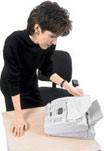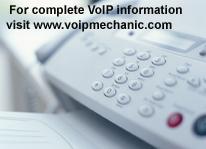Faxing over VoIP
VoIP Faxing; Faxing over VoIP can be a challenge, but with a few configuration changes on your current fax machine, you may find fairly reliable faxing over your VoIP Internet connection.
Faxing over a VoIP connection.
Information on Alarms and Credit Card machines over VoIP
First some background on faxing and VoIP.
Faxing has been around for years and most of the protocols were written with the intent of sending those signals over traditional phone circuits using sounds. Those sounds were turned back into data by the receiving fax machine, which expects a constant, steady transmission of data, without any loss. If there is some loss of data the receiving fax machine will shut down the transmission.
The problem is that the codecs used by VoIP IADs are designed to compress voice, not the analog signals sent and received by modems.
In a VoIP Internet world, voice is first converted into packets and then they are sent over the connections that make up our our vast Internet. They may take slightly different times to arrive at their destination. In doing so some packets may be discarded, but the end result is that the receiving VoIP device has enough packets to make a clear and understandable conversation.
We suggest these settings on a fax machine for faxing over VoIP; slowing the transmission rate down and allowing the machine to continue receiving the transmission even though a few bits of data were lost, then faxing over VoIP can become more consistent. Our suggestions in many cases can resolve issues that prevent faxing over a VoIP connection, but not in all cases. If after trying and making all the VoIP fax changes we suggest you still cannot fax over your connection then try a Internet Fax service.
G711 or Non-Compressed Codec
First make sure that your VoIP fax connection (the line that you fax on) is set to G711. This is a non-compressed codec. G729 uses compression and will make the fax fail. Some providers have a "Bandwidth Saver" setting. This would be a compressed codec. Make sure this is Not enabled. If you do not have access to this setting call your provider and make sure your connection is set for G711.
 You will want to make these changes:
You will want to make these changes:
- Slow down the transmission speed. Set the BAUD rate of the fax machine to 9600 bps or even lower (7200 bps would be the next slower setting).
- Turn off or disable ECM (error correction mode), a setting, usually defaulted on, that many fax machines have.
Test faxing by using the HP Test Fax Service:
- You can use the following number to test your fax and get a response fax sent right back to you. Send a one page blank fax to 1-888-473-2963 (1-888-hpfaxme). After receipt of your fax, the test fax will generate a return back to you with acknowledgement that your fax was received. You should receive this fax within 5 minutes.
More on Baud rates & ECM settings:
We have added some additional information about these two important settings and included some instructions on making these adjustments on some fax machines. voip fax settings
There are some other things that you will want to check,
especially if you are still experiencing communication
errors. Some fax machines, especially Brother, have an Overseas Mode, which
can be enabled before a
 fax. This setting makes temporary changes to the fax tones to
accommodate noise and static and should be set before each outgoing
fax. Check for the following:
fax. This setting makes temporary changes to the fax tones to
accommodate noise and static and should be set before each outgoing
fax. Check for the following:
- Use a direct connection from the IAD to the fax machine. Try removing any splitters and other devices in that line. Some devices may interfere with the fax transmission, such as, answering machines and caller IDs.
- Try enabling Overseas Mode.
- Change the resolution setting to Standard, rather than super fine. This limits the amount of packets that need to be transmitted.
- If your fax machine is not connecting to the receiving fax machine try disabling or clearing any stutter tones that may be present on the line. Many VoIP providers use a stutter tone to notify the user of new Voice Mail. These stutter sounds will confuse the fax machine.
- Try to set the CHG Tone MIN Count setting.
- Try plugging in the power adapter (cord) directly into a wall socket, rather than a power strip or surge protector.
- Try placing a DSL filter in reverse position between the ATA and the fax machine.
If you having problems connecting and are getting a fast busy signal when faxing, your fax machine is most likely not getting connected. (Try dialing the fax number from a different phone, and first check if you hear rings and then receive the traditional fax tone, as a test.) If so, then you will want to check the fax connection for the following:
- Do you have dial tone at the fax machine and is the connection into the proper IN-Line port of the fax machine?
- Is the fax machine dialing the proper number? If a 1 needs to be added to long distance, is it being added correctly?
Settings to fax over VoIP for Canon fax machines.
Try these settings to for VoIP for Panasonic fax machines.
When faxing over VoIP with a Brother Fax machine make these settings changes.

